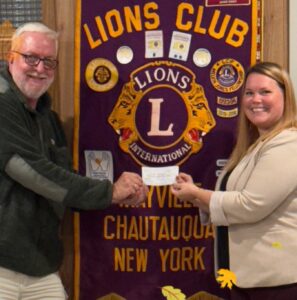Third regular meeting of the Fredonia Shakespeare Club held
The third regular meeting of the 2025-2026 season of the Fredonia Shakespeare Club was hosted at the home of Lucille Richardson. President Karin S. Cockram welcomed Club members to the meeting.
After the business meeting concluded, a paper by Joan Larson on Monticello, Va., which is one of 26 UNESCO World Heritage sites in the United States was presented.
Monticello was the primary residence and plantation of Thomas Jefferson, a Founding Father, author of the Declaration of Independence, and the third president of the United States. Jefferson began designing Monticello after inheriting land from his father at the age of 14. Located just outside Charlottesville, Virginia, in the Piedmont region, the plantation was originally 5,000 acres with Jefferson using the forced labor of enslaved black people for extensive cultivation of tobacco and mixed crops, later shifting from tobacco cultivation to wheat in response to changing markets.
Due to the architectural and historic significance, the property has been designated a National Historic Landmark in 1987. Monticello and the nearby University of Virginia, also designed by Jefferson, were together designated a UNESCO World Heritage Site. The United States nickel has featured a depiction of Monticello on its reverse every year since 1938 except for 2004-05. Jefferson designed the main house using neoclassical design principles pioneered by Italian Renaissance architect Andrea Palladio and reworking the design through much of his presidency to include design elements popular in the late 18th-century Europe and integrating numerous ideas of his own. Situated on the summit of an 850 ft.-high peak in the Southwest Mountains south of the Rivanna Gap, the name Monticello derives from Italian meaning “little mountain”. Along a prominent lane adjacent to the house, Mulberry Row, the plantation came to include numerous outbuildings for specialized functions, e.g. a nailery: quarters for slaves who worked in the home gardens for flowers, produce, and Jefferson’s experiments in plant breeding–along with tobacco fields and mixed crops. Cabins for slaves who worked in the fields were farther from the mansion.
At Jefferson’s direction, he was buried on the grounds in an area now designated as the Monticello Cemetery. The cemetery is owned by the Monticello Association, a society of his descendants through Martha Wayles Skelton Jefferson. After Jefferson’s death, his daughter Martha Jefferson Randolph, apart from the small family graveyard, sold Monticello. In 1834, it was bought and saved from ruin by Uriah P. Levy, a commodore in the U.S. Navy who admired Jefferson and spent significant funds to preserve the property. His nephew, Jefferson Monroe Levy took over the property in 1879; he also invested considerable funds to restore and preserve it. In 1923, Monroe Levy sold it to the Thomas Jefferson Foundation (TJF), which operates it as a house museum and educational institution.
The paper continued to describe the design of the building, the European influence Jefferson used throughout. The decorations, paint color and furnishings along with the design and purpose of the rooms was a part of Jefferson’s plan for Monticello.
An interesting fact is that Monticello is the birthplace of macaroni and cheese in the United States. It is believed that Jefferson’s enslaved cook, James Hemings, perfected the dish similar to how it is prepared today.
Marilyn Thaxton, Joan’s daughter, showed a video of Monticello. The group was able to visit the inside and outside of the mansion and grounds. Nickels, pens and peanuts, items related to today’s topic, were favors for the members.
Jefferson wrote to his neighbor in 1787 that he was happiest at Monticello because it was a place of beauty, peace and order enveloping the warmth of family, a true personal sanctuary.
Following the paper presented by Larson all members were treated to an array of snacks provided by Lucille Richardson.



